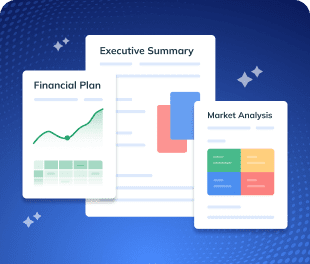So, you’re jumping into real estate. Great move!
Starting out as an agent is exciting. You get to build your own thing, help people find their dream homes, and maybe even escape the whole 9-to-5 routine.
But enthusiasm alone won’t keep the business running or pay the bills. Turning that into a real, steady business, you’ll need a solid plan to set clear goals, figure out how to find clients, stay organized, and not burn out in the process.
Never written one before?
No problem! This free real estate business plan template is here to walk you through it, step by step.
What’s the importance of a real estate business plan?
Many people jump into real estate with big dreams but no real plan. They might think, “I’ll just get my license and start selling houses.”
Unfortunately, the reality isn’t so simple!
According to statistics shared by the National Association of Realtors (NAR), 75% of real estate agents fail within their first year, and 87% fail within five years. Those numbers are eye-opening, and a lack of proper planning is a major reason why so many new agents struggle.
That’s why keeping a real estate agent business plan is important because it gives you a clear direction and a strategy to follow. It helps you figure out critical details like:
- Who are your potential clients?
- How will you attract and serve those clients?
- What are your income and expenses? How will you make profits?
- What makes you different from other agents?
Without a plan, you’re guessing your way through. That can mean spending too much on marketing, not giving clients the same level of service, and missing chances to grow.
But with a business plan, you’re not guessing—you’re planning. You can set your goals, check your progress, and shift your approach when things change.
In short, a business plan helps you take control of your real estate business from day one.
How do you write a real estate agent business plan?
In this step-by-step guide, you’ll learn what a winning real estate agent business plan includes and how to structure it.
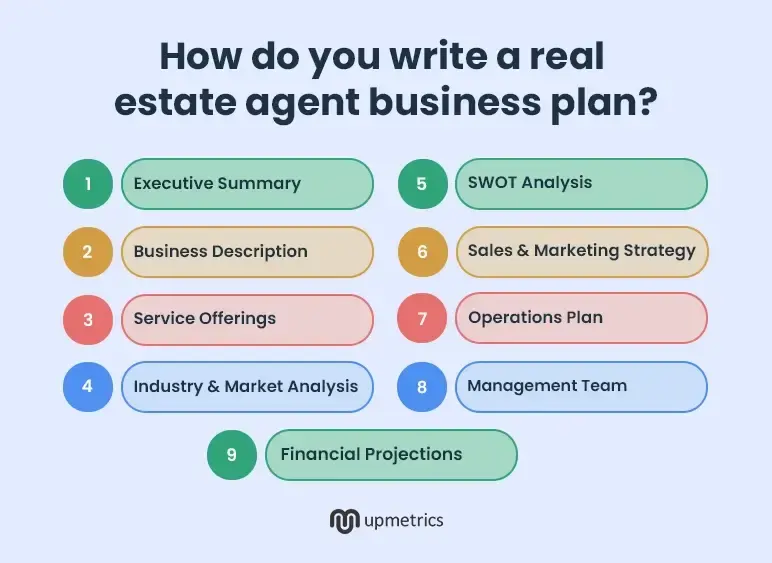
Let’s break down each key component you should include:
1. Executive Summary
The executive summary is like an elevator pitch for your entire real estate agent business plan.
It gives readers—whether they’re potential investors, partners, or just you reviewing your plan—a quick overview of what your real estate business is all about and why it will succeed.
Even though it appears first, it’s often best to write this section last after you’ve worked out all the details in the rest of your plan.
In a real estate agent’s executive summary, you should briefly cover the following key aspects:
- Real estate business name and location
- Your target market
- Unique Selling Propositions (USPs)
- Business goals
- Financial outlook
- Funding needs (If any)
The goal is to grab the reader’s attention and give them the essence of your plan, and persuade them to learn more. So, keep the executive summary clear and concise—about one page or 2–3 short paragraphs.
Say goodbye to boring templates
Build your business plan faster and easier with AI
Plans starting from $14/month

2. Business Description
This section is where you describe your real estate business in detail; think of it as the “who, what, where, and why” of your venture.
The business description provides the foundational information about your agency or practice. It helps anyone reading the plan understand exactly what you’re building.
Here are a few key questions to answer while drafting your business description:
- What is the registered name of your real estate business, and where do you operate?
- What’s your legal setup? Are you working under a broker, starting an LLC, forming a partnership, or setting up your own firm?
- What’s the purpose of your business, and what do you hope to achieve?
- What led you to real estate? What motivated you to start this business?
- What do you want to achieve, both in the short term and long run?
Overall, the business description paints a picture of your company’s identity and direction. Hence, make sure this section is clear, straight to the point, and impactful.
3. Service Offerings
In the real estate world, your service offerings are essentially what you offer to clients as an agent.
In this section of your business plan, list and describe the core services you provide (or plan to provide) to generate revenue. For most real estate agents, the primary services will be helping clients buy and sell properties.
Common service offerings for a real estate agent include:
- Residential sales for buyers
- Residential sales for sellers
- Rentals or leasing (if applicable)
However, think about specifics and any additional services that can add value or extra income streams. For instance:
Do you offer real estate consulting services for investors (e.g., offering market analysis for a fee)? Do you plan to property manage for clients (manage rentals)?
4. Industry and Market Analysis
Before you start selling houses, understand the market you’re stepping into. This section helps. It shows that you’ve done your homework on the real estate industry and your specific local market.
Conducting a thorough analysis helps you demonstrate your knowledge of the housing market, real estate industry trends, target clients, and competition.
While planning this section, consider including these key elements:
Industry Overview
Briefly describe the real estate industry’s current state. Is the market hot or cooling in your area? What are the current trends in real estate?
For example, are interest rates rising (which might slow down sales), or are people moving into your city because of new job opportunities? Mentioning relevant trends shows you’re aware of the bigger picture.
Target Market and Customer Insights
Identify who exactly your ideal clients are and what they want.
Are you focusing on first-time homebuyers, empty nesters looking to downsize, real estate investors, or perhaps luxury home sellers?
Describe their needs and preferences. The better you understand your audience, the easier it will be to personalize your services to them.
For that, you can create a detailed buyer persona for your real estate brokerage business and know what your ideal clients are really looking for. For instance:
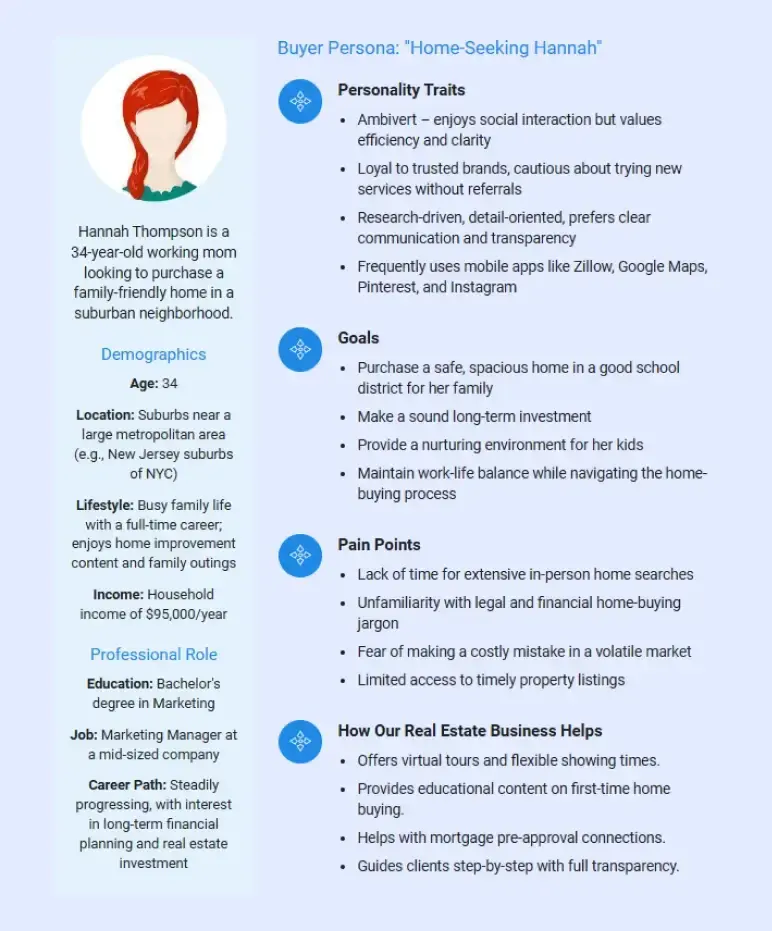
Local Market Research
Dive into your specific area or niche.
- What’s the median home price in your target neighborhoods?
- How many homes get sold per month on average?
- Is there more demand for homes than supply (a seller’s market) or vice versa?
Include facts or figures if you have them, such as housing inventory levels or price trends.
Competitive Analysis
Real estate is a competitive field. There are likely many other agents or teams vying for the same clients.
In this part, identify your main competitors (other agents or brokerages in your area) and note what they’re doing.
- How many agents are top producers in your neighborhood?
- Who are your biggest competitors?
- What are their strengths or specialties?
- And where do they fall apart (their weaknesses)?
By analyzing the competition, you can find gaps or areas where you can stand out. Ask yourself: What do successful agents in my market do, and how can I do it better or differently?
5. SWOT Analysis
A SWOT Analysis is a handy framework to evaluate your business’s Strengths, Weaknesses, Opportunities, and Threats. It’s basically a quick snapshot of where you stand and what external factors you should be aware of.
If you’re a new real estate agent, doing a SWOT analysis can really help. It lets you see what you’re already good at, where you might need to improve, what chances you can grab, and what problems to watch out for.
Here’s a quick example of what that might look like for someone just starting out:
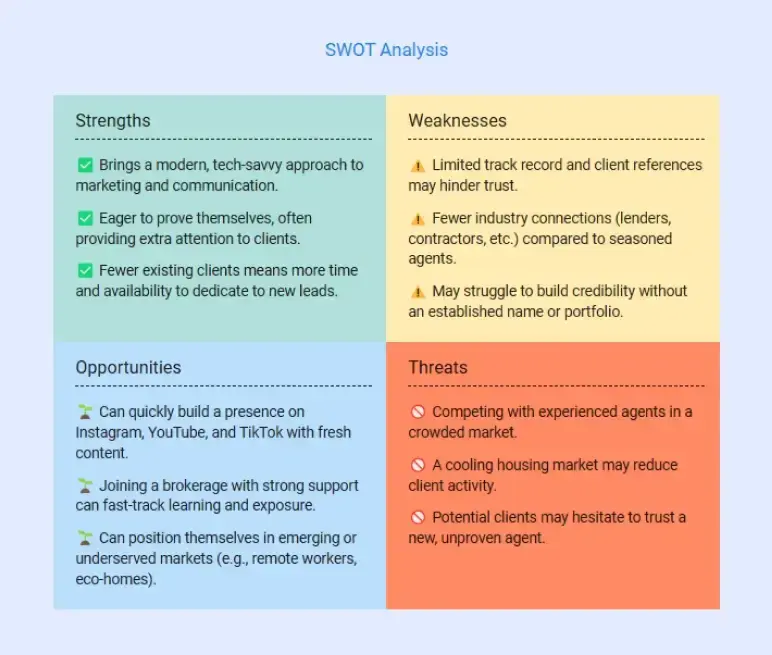
By including a SWOT analysis, you show the reader that you know where you’ll need support and where you can shine, which makes your overall business plan more credible.
Plus, it’s a great exercise for you as an entrepreneur. It encourages strategic thinking about your real estate business environment.
6. Sales and Marketing Strategy
No matter how great of an agent you are, clients won’t magically appear. You absolutely need a solid sales and marketing strategy to attract and win business.
This section of your plan details how you’ll promote your services (marketing) and how you’ll close deals and generate revenue (sales). Essentially, how will you connect with potential clients and persuade them to work with you?
Here’s how to break down your real estate marketing and sales plan:
Marketing Strategy
This is all about lead generation—making sure people know about you and want to reach out. Consider multiple channels and tactics, such as:
- Build a professional website to show your listings and services
- Use social media (Facebook, Instagram, LinkedIn) to share updates, listings, and client reviews
- Run online ads (Google or Facebook) to reach people in your local area
- Network with local groups and professionals
- Join your local Chamber of Commerce or sponsor community events
- Try traditional marketing like flyers, postcards, or local ads
- Host workshops for first-time buyers, homeowners, or real estate investors
Sales Strategy
Marketing might get you leads, but your sales strategy is how you turn those leads into clients and closed deals.
In this part, explain your approach to handling inquiries and guiding clients through transactions, including: Lead follow-up, Consultation and conversion, Client service and retention, Sales targets
By detailing your marketing and sales strategy, you prove that you have a plan to actively grow your business, not just passively hope for clients.
7. Operations Plan
The operations plan is the behind-the-scenes look at how you’ll run your real estate business day-to-day. It answers the question:
What does it take to deliver your services efficiently and effectively?
While a lot of real estate work happens in the field (showing homes, meeting clients), there’s also a fair amount of organization and process needed to keep everything running smoothly.
Here’s how to approach your operations plan section:
- Describe where and how you’ll operate. Do you have a home office or physical location?
- List the basic tools or equipment you’ll use. Also, mention any software or systems.
- Explain how you’ll divide your time between tasks like lead generation, client meetings, showings, and paperwork
- Mention any support you have now, and if you plan to hire help as your business grows
- Outline your process for handling new listings and onboarding new clients
- Describe how you’ll manage client relationships and provide support after a sale
- Briefly mention your backup plan for handling busy seasons or unexpected challenges
By detailing your operational aspects, you demonstrate that you know how to execute your plan on a practical level. Also, it assures the reader (and yourself) that you have the systems and processes to handle everything efficiently.
8. Management Team
Investors and stakeholders don’t just invest in ideas; they invest in people.
The management team section highlights who is running the show and why they’re capable of making this real estate venture a success.
In many single-agent businesses, “team” might just be you, and that’s okay! The key is to showcase your qualifications, as well as any other key players or advisors behind the scenes.
Start this section with your profile. As an owner/agent, provide an overview of your experience and qualifications.
As a real estate agent, you typically operate under a licensed broker (unless you are one). Mention the brokerage you’ve joined (or will join) and the support system there. This shows you’re not completely alone and have resources to lean on.
If you have co-founders, a real estate team, or even an assistant, mention them here. List their names, roles, educational qualifications, and relevant experience. Keep it simple but impactful.
You can even create an organization chart for a better understanding of the team structure and how decisions are made. Something like this:
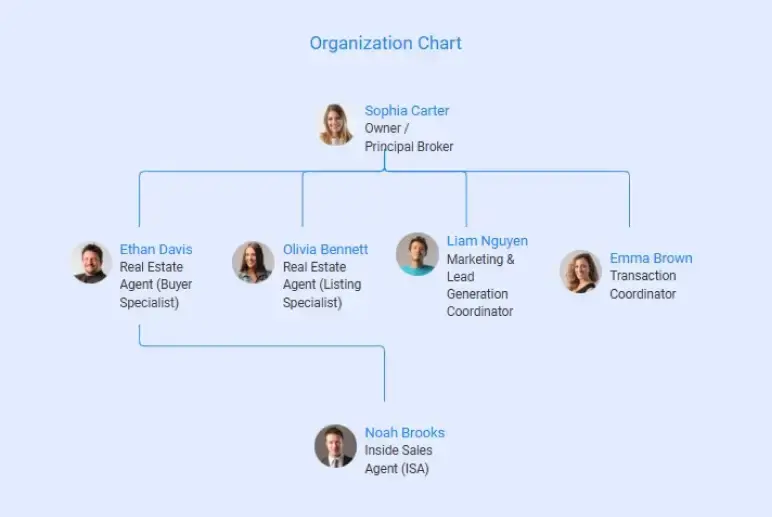
While not a formal “team member,” a strong network can be a selling point. You can mention that you have relationships with key professionals like mortgage brokers, real estate attorneys, home inspectors, contractors, etc.
This indirectly highlights your management ability – you know how to leverage relationships to get things done.
9. Financial Projections
The financial projections section is where you lay out the expected financial performance of your real estate business for the next 3-5 years of operation.
Even if math isn’t your favorite part, this section is incredibly important. It shows that your business can be profitable and that you’ve thought through the money side of things.
If you’re using the plan to seek funding or just to budget for yourself, solid projections will guide your decisions.
Here’s what to include in the financial plan for a real estate agent business:
- Revenue projections
- Operating expenses
- Profit and loss statement
- Cash flow estimates
- Projected balance sheet
- Break-even analysis
- Funding requirements (if any)
Also, consider seasonality—often real estate sales peak in spring/summer and slow in winter; your monthly projections should reflect such trends.
Be realistic with your projections. It’s better to be slightly conservative and then hopefully exceed your targets. Lastly, don’t forget to highlight any assumptions. It sets context for your numbers.
For example, you may consider formulating the financial statements as shown below:
Income Statement
| Category | Year 1 (2024) | Year 2 (2025) | Year 3 (2026) |
|---|---|---|---|
| Revenue | |||
| Commission Income | $420,000 | $500,000 | $580,000 |
| Listing & Service Fees | $40,000 | $50,000 | $60,000 |
| Buyer Representation Fees | $95,000 | $115,000 | $135,000 |
| Referral/Other Income | $10,000 | $15,000 | $18,000 |
| Total Revenue | $565,000 | $680,000 | $793,000 |
| Expenses | |||
| Agent Commissions | $230,000 | $275,000 | $320,000 |
| Marketing & Advertising | $45,000 | $55,000 | $60,000 |
| Office Rent | $24,000 | $26,000 | $28,000 |
| Salaries & Wages | $70,000 | $78,000 | $85,000 |
| Tech & CRM Tools | $6,000 | $7,000 | $7,500 |
| Legal, Licenses, Insurance | $3,500 | $4,000 | $4,500 |
| Travel & Transportation | $4,000 | $5,000 | $5,500 |
| Miscellaneous | $2,500 | $3,000 | $3,500 |
| Total Expenses | $385,000 | $453,000 | $514,000 |
| Net Profit (Before Tax) | $180,000 | $227,000 | $279,000 |
Balance Sheet
| Category | Year 1 (2024) | Year 2 (2025) | Year 3 (2026) |
|---|---|---|---|
| Assets | |||
| Cash on Hand | $55,000 | $80,000 | $105,000 |
| Accounts Receivable | $28,000 | $32,000 | $36,000 |
| Equipment (Net) | $12,000 | $10,000 | $8,000 |
| Prepaid Expenses | $3,500 | $3,000 | $2,800 |
| Total Assets | $98,500 | $125,000 | $151,800 |
| Liabilities | |||
| Accounts Payable | $8,000 | $9,000 | $10,000 |
| Short-Term Loan | $15,000 | $10,000 | $5,000 |
| Total Liabilities | $23,000 | $19,000 | $15,000 |
| Equity | |||
| Owner’s Capital | $20,000 | $20,000 | $20,000 |
| Retained Earnings | $55,500 | $86,000 | $116,800 |
| Total Equity | $75,500 | $106,000 | $136,800 |
| Total Liabilities & Equity | $98,500 | $125,000 | $151,800 |
Cash Flow Statement
| Category | Year 1 (2024) | Year 2 (2025) | Year 3 (2026) |
|---|---|---|---|
| Cash from Operating Activities | |||
| Net Profit Before Tax | $180,000 | $227,000 | $279,000 |
| Depreciation | $2,000 | $2,000 | $2,000 |
| Change in Receivables | ($10,000) | ($4,000) | ($4,000) |
| Change in Payables | $4,500 | $1,000 | $1,000 |
| Net Operating Cash Flow | $176,500 | $226,000 | $278,000 |
| Cash from Investing Activities | |||
| Equipment Purchase | ($5,000) | ($3,000) | ($2,000) |
| Net Investing Cash Flow | ($5,000) | ($3,000) | ($2,000) |
| Cash from Financing Activities | |||
| Owner’s Capital Injection | $20,000 | — | — |
| Loan Repayment | ($5,000) | ($5,000) | ($5,000) |
| Net Financing Cash Flow | $15,000 | ($5,000) | ($5,000) |
| Net Change in Cash | $186,500 | $218,000 | $271,000 |
| Opening Cash Balance | $0 | $55,000 | $80,000 |
| Ending Cash Balance | $55,000 | $80,000 | $105,000 |
Download a free real estate agent business plan template
Need help writing your real estate agent business plan from scratch? Worry not! We’ve got you covered. Download our free real estate agent business plan template to jumpstart your planning process.
This template is specifically designed for real estate professionals and includes all the sections we discussed above, pre-formatted and ready for your details. Just plug in your information and have a polished plan in no time without missing any crucial components.
The Quickest Way to turn a Business Idea into a Business Plan
Fill-in-the-blanks and automatic financials make it easy.
Summary
Let’s wrap up! We’ve covered all the key components of a real estate agent business plan – from the executive summary that gives the big picture, to the nitty-gritty of financial projections. Now, it should be much easier for you to drfat your own business plan.
But if you’re still feeling confused or seeking an easy way to create a plan, tools like Upmetrics can make the process easier.
It’s an intuitive business plan software that involves an advanced AI business plan generator as well as a financial forecasting feature to simplify planning and generate detailed, professional-looking plans that impress investors.
So, take advantage of the resources available and start writing a plan!

